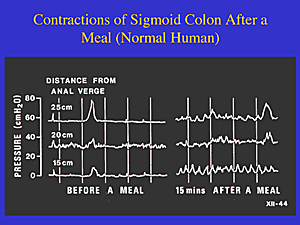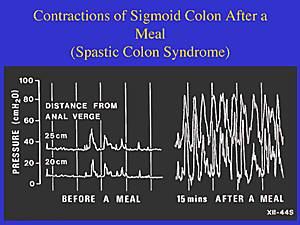| |
 |

Special Deal!
Tummy Fiber Can,
Tummy Fiber Pouch,
and Stick Packs!
For IBS diarrhea and constipation!

Heather's Tummy Care
Now at Select CVS Pharmacies!
|
 |
|
| |


Share!


December 17, 2013 ~ Scroll down for full newsletter or follow the links:
Ask Heather »
IBS is a Brain-Gut Disorder. What Does That Mean?!
Special Letter »
Meet Peg! In and Out of the Hospital, Constipation Now Gone!
IBS Recipe »
Pumpkin Apple Spice Bread - it's Peg's Favorite!

|
|
Have questions? Call toll free (866) 640-4942.
Outside the US (206) 264 8069.
Enjoy the newsletter!
Heather Van Vorous & Heather's Tummy Care
Over 10 Years of IBS Business!
|
Did a friend send you this newsletter? Sign up here for your own free subscription.

Pumpkin Apple Spice Bread This is everybody's favorite bread! It's moist, richly spiced, and just plain wonderful. This recipe makes two big loaves - one for you, and one to give to someone you really love.
Makes Two 9 x 5" loaves, 16 slices per loaf
Preheat oven to 350 F.
Topping:
1 tablespoon all-purpose unbleached white flour
5 tablespoons brown sugar
1 teaspoon cinnamon
1 tablespoon canola oil
Combine all ingredients in a small bowl. Set aside.
Sift into a large bowl:
3 cups all-purpose unbleached white flour
3 tablespoons Acacia Tummy Fiber
3/4 teaspoon salt
2 teaspoons baking soda
1 1/2 teaspoons cinnamon
1 teaspoon nutmeg
1 teaspoon cloves
1/4 teaspoon allspice
1/4 teaspoon ginger
Whisk dry ingredients with a metal whisk until thoroughly blended.
In a large bowl beat well with an electric mixer:
16 oz. can pumpkin
3/4 cup canola oil
2 1/4 cups granulated sugar
8 organic egg whites
Fold into wet ingredients:
2 large Granny Smith apples, peeled and chopped (about 2 cups)
With a wooden spoon, add the dry ingredients to the wet, stirring the batter by hand just until well blended. Pour batter into two non-stick loaf pans sprayed with cooking oil. Sprinkle on topping. Bake for about 50-60 minutes or until a toothpick or cake tester inserted into the center of the loaf comes out clean. Cool on racks.
For thousands of delicious recipes, come visit the IBS Recipe Exchange!
Are you just learning how to eat for IBS? A little intimidated at the thought of special IBS recipes? Not quite sure just what makes these recipes special in the first place? Don't worry! Get Eating for IBS and find the answers to all your questions.

With Fennel and Peppermint Tummy Teas, Plus Peppermint Oil Caps
For bloating, gas, and preventing IBS abdominal pain!
 In and Out of the Hospital, Constipation Now Gone!
In and Out of the Hospital, Constipation Now Gone!
Heather,
I just wanted to say thank you so much for being there. I have suffered for years with no relief. I am on the end of this that causes severe constipation which has landed me in the hospital time and again. With this last severe bout, I told myself I have to find something that helps. Well, you are that something.
Your books gave me sooooooo much info that even the docs did not tell me. I have been following your diet and using your system for a month now. Guess what? I am feeling great, and my constipation is all but gone. I just wanted you to know how grateful I am. You are a life saver.
Feel free to use my comments on your website. My hope is that everyone who suffers as we do, will find you. You have just been a lifesaver for me. I was at the point that I just could not live with this disease, it's horrible, but thanks to you, you have done what my doctors have failed to do. Thank you so very much.
Oh by the way, I love your IBS cookbook. I practically live on your pumpkin bread. YUMMM!
Bright Blessings to you,
Peg M.
Thank you so very much, Peg! I am thrilled to hear this - and to feature the recipe for your favorite pumpkin bread. I love it too! ~ Heather

Try the IBS Diet Kit #2 - for Diarrhea AND Constipation!
* Eating for IBS - the Groundbreaking Diet and Cookbook
* Organic Acacia Tummy Fiber ~ for IBS Pain, Diarrhea and Constipation!
* Peppermint Oil Tummy Tamers with Fennel Oil ~ prevent bloating and gas!
 IBS is a Brain-Gut Disorder. What Does That Mean?! IBS is a Brain-Gut Disorder. What Does That Mean?!
Irritable Bowel Syndrome, also known as IBS, is defined by the Rome Criteria diagnostic guidelines, and is characterized as a brain-gut dysfunction. What on earth does this mean?
In plain English, it means that IBS symptoms result from a hypersensitivity of the nervous system of the gut (your gut overreacts), along with misinterpretations of the nervous system messages from the gut by the central nervous system and the brain (your brain overreacts to your gut's overreaction).
Basically, this circuit (from gut to brain and brain to gut) appears to be abnormal in patients with Irritable Bowel Syndrome, though the exact abnormalities remain unclear.
(For full information about the brain-gut dysfunction and Irritable Bowel Syndrome overall, get The First Year: IBS, an essential guide to successfully managing the disorder. This is extremely helpful for both the newly diagnosed and those who have been struggling with IBS for years.)
Remarkably, PET scans of the brains of people with IBS show pronounced differences in the activation of certain parts of the brain relating to perception and pain (versus normal individuals). MRI brain scans have shown similar results. Yes, this means that those of us with IBS have a brain disorder, not just a gut disorder.
This also means that IBS is undeniably a physical problem. Simply put, the brain-gut interaction of people with IBS influences their bowel pain perception and motility. In a nutshell, the processing of pain information within the central nervous system varies between normal individuals and those of us with IBS, with the result that we can experience even normal GI contractions as painful.
The interactions between our brains, central nervous systems, and GI systems are just not functioning properly. We have colons that react to stimuli that do not affect normal colons, and our reactions are much more severe.
The end result is heightened pain sensitivity and abnormal gut motility, in the form of irregular or increased GI muscle contractions. It is this gut overreaction and altered pain perception that cause the lower abdominal cramping and accompanying diarrhea and/or constipation that characterize IBS.
The fastest and easiest way to break this cycle, stop the gut overreaction, and manage symptoms on a daily basis is to use a prebiotic 100% soluble fiber supplement that's formulated specifically for IBS. That will help regulate your gastrocolic reflex and keep peristalsis normal. This prevents abdominal spasms and cramps, and relieves both diarrhea and constipation.
Interestingly though, while an underlying cause of IBS might well be in our brains, there is still a physical abnormality in the way our colons function. This dysfunction is actually visible (shockingly so) in the medical imaging tests below.

This is a normal gut 15 minutes after a meal.

This is an IBS gut 15 minutes after a meal. Holy cow!
Illustration from Irritable Bowel Syndrome (IBS): Examining New Findings and Treatments. Authors: Marvin M. Schuster, MD; Michael D. Crowell, PhD; Nicholas J. Talley, MD, PhD. Continuing Medical Education Activity, Johns Hopkins School of Medicine, October 26, 2000, via Medscape. Used with permission.
Typically, the majority of the time the colon is still. However, following a meal, the stomach triggers something called the "gastrocolic reflex." This response occurs when food passes from the stomach into the upper part of the small intestine.
Normally, the gastrocolic reflex causes periodic contractions of the colon at different points along its length, at timed intervals. These segmented contractions regulate the flow of waste, and keep it in contact with the bowel wall, allowing water to be absorbed.
Finally, peristaltic contractions of the colon propel the waste to the rectum and then out of the anus via evacuation by a bowel movement. Total average transit time through the entire 30-foot digestive system, from mouth to anus, is between 12-24 hours for healthy individuals with high-fiber diets, and 48-72 hours for most Americans eating a typical Western (high fat/animal protein, low fiber) diet.
Where Things Go Wrong...
Unfortunately, how the digestive tract is supposed to work is not exactly how it does work for those of us with IBS. The key problem seems to be with the gastrocolic reflex. Specifically, research has found that many IBS patients have highly abnormal ones.
Our colons have disorganized and significantly more violent and prolonged contractions (leading to diarrhea), or almost no contractions at all (resulting in constipation).
Amazingly, researchers have found that while healthy people have between 6-8 peristaltic contractions in their colon within a 24-hour period, IBS sufferers with diarrhea have as many as 25 peristaltic contractions per day, and constipation-prone IBS patients have almost none.
Add to this bowel dysfunction the heightened pain perception resulting from our abnormal brain-gut interactions, and you've got the recipe for disaster...spelled I-B-S.
There's vivid demonstration of this in the images above. They show the huge difference between the after-meal contractions of a normal person's lower (sigmoid) colon and the contractions of the lower (sigmoid) colon in a person with IBS. The left half of both illustrations shows the colon contractions before a meal, and the rates are very similar and quite modest.
Just fifteen minutes after eating, however, the differences in colon contractions as shown on the right sides of the graphics are dramatic. Given the almost off-the-chart severity of the spasms (measured by the vertical axis in terms of pressure) in the IBS patient, it's easy to literally see exactly why the pain and bowel dysfunctions of this disorder can be so extreme.
As you read these graphics, don't be intimidated by the "distance from anal verge" legend for the horizontal axis of the chart. All that term basically means is how far up into the colon from the anus the contractions are being measured (they're either 15, 20, or 25 centimeters up into the colon from the outside of the anus).
In other words, the contractions triggered by the gastrocolic reflex from the stomach are affecting the very lower end of the colon just fifteen minutes after a meal has been eaten. This gives a crystal clear explanation for how an attack can hit you so fast and so hard after - or even while - eating. Personally, I can't look at these charts without having flashbacks to all the times I've had to rush from the dinner table before I'd even finished my meal.
So now that you know it's a brain-gut dysfunction that underlies all IBS symptoms, what can you actually do about it?
My top recommendation is gut-directed hypnotherapy. It's one of the most promising methods of treating IBS permanently (researchers have actually called it a cure).
This is the only treatment that actually deals directly with, and can successfully change, the brain-gut dysfunction. See the News and Research section for an overview of articles and reviews of hypnotherapy for IBS, including researchers' conclusions that hypnotherapy not only relieves IBS symptoms but also appears to restore many of the psychological and physiological abnormalities associated with these symptoms.
In other words, if your goal is to physically change the brain-gut disorder that actually causes IBS symptoms in the first place, gut-directed hypnotherapy is not just the only option, it is a truly terrific one.
Hypnotherapy specific to IBS has long been a mainstream treatment in Great Britain, where this treatment was originally pioneered. However, it has now been embraced by US gastroenterologists and GI researchers as well. It is one of the most thoroughly researched and well-established therapies for all IBS symptoms, and the only one so far that has demonstrated potential for permanent results.
There is much to gain and literally nothing to lose by trying hypnotherapy for IBS to break the cycle of the brain-bowel dysfunction.
~ Heather


Shop at Heather's Tummy Store for IBS
HelpForIBS.com
The only store that's just for IBS - so we only carry the very best

You're on this newsletter list because you have expressed interest in IBS news and information.
Unsubscribe Here
Change your newsletter email address here.
If you are viewing this newsletter on a website and would like to subscribe for email delivery, please "Join the IBS Newsletter" here.
ANTI-SPAM PRIVACY & SECURITY POLICY
HelpForIBS.com
Heather's Tummy Care
80 S. Washington St, #304
Seattle, WA 98104 USA
© 2013 Heather Van Vorous, Heather's Tummy Care. All rights reserved.
Authored by Heather Van Vorous. May not be reproduced without permission.
USA Copyright Office Registration Number TXU 1-270-858 and others.
|
|
| |